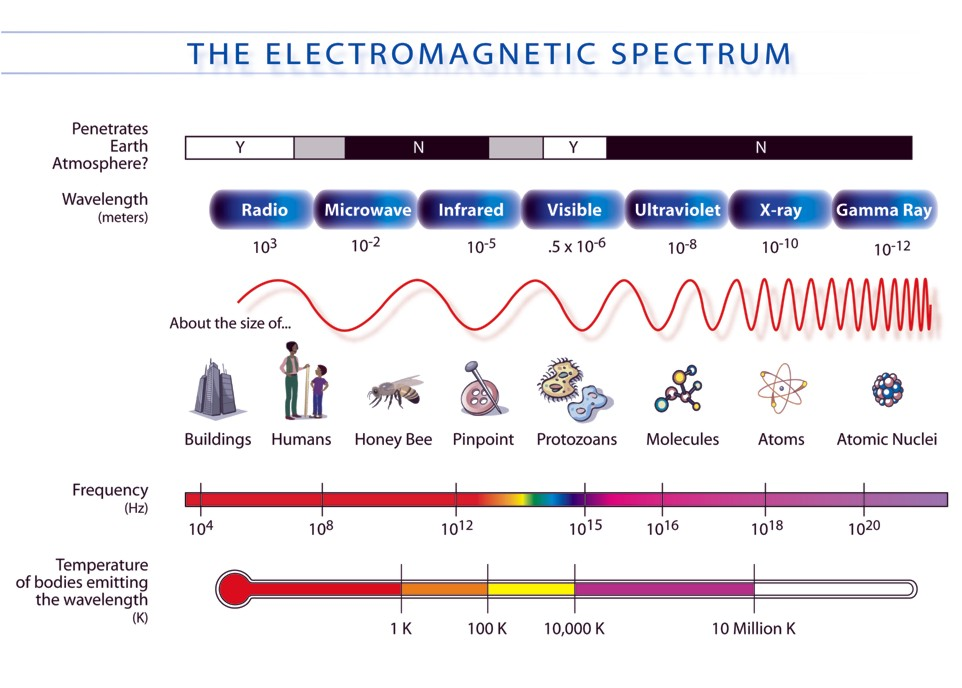Electromagnetic Waves: A Comprehensive Guide
Introduction to Electromagnetic Waves
Electromagnetic waves are an essential component of the universe, transferring energy across space without requiring a medium. Produced by vibrating charged particles, these waves are unique in their ability to travel through a vacuum and are always transverse, meaning their oscillating electric and magnetic fields are perpendicular to each other and to the wave’s direction of travel.
Understanding electromagnetic waves is crucial for exploring their role in communication, medicine, and imaging technologies, as well as their broader impact on everyday life.
What Are Electromagnetic Waves?
An electromagnetic wave consists of:
- Electric Fields: Oscillating up and down.
- Magnetic Fields: Oscillating side to side.
- Direction of Propagation: Perpendicular to both fields.
When traveling through a vacuum, electromagnetic waves move at a constant speed, denoted as c, the speed of light:
c ≈ 3 × 10⁸ m/s

Key Properties of Electromagnetic Waves
- Travel at the speed of light in a vacuum.
- Characterized by frequency (measured in hertz) and wavelength (measured in meters).
- Transfer energy through oscillating electric and magnetic fields, without needing a physical medium.
The fundamental relationship between wave speed, frequency, and wavelength is expressed as:
c = λf
Where:
- : Speed of light (≈ 299,792,458 m/s).
- : Wavelength.
- : Frequency.
The Electromagnetic Spectrum: A Range of Waves
The electromagnetic spectrum encompasses all types of electromagnetic waves, categorized by wavelength and frequency. These waves range from the longest wavelengths (radio waves) to the shortest (gamma rays).
Categories of the Electromagnetic Spectrum
Radio Waves
- Wavelength: Longest
- Frequency: Lowest
- Applications: Communication (TV, radio, cell phones)
Microwaves
- Wavelength: Shorter than radio waves
- Applications: Cooking, radar, satellite communication
Infrared Waves
- Wavelength: Shorter than microwaves
- Applications: Thermal imaging, remote controls, heating
Visible Light
- Wavelength: Narrow band detectable by the human eye (~400-700 nm)
- Applications: Vision, lighting, photography
- Colors (ROYGBV): Red, Orange, Yellow, Green, Blue, Violet
Ultraviolet (UV) Rays
- Wavelength: Shorter than visible light
- Applications: Sterilization, tanning, detecting biological materials
- Caution: Overexposure can damage living tissue.
X-rays
- Wavelength: Shorter than UV rays
- Applications: Medical imaging, cancer treatment
Gamma Rays
- Wavelength: Shortest
- Frequency: Highest
- Applications: Cancer treatment, nuclear energy

Key Features of the Electromagnetic Spectrum
- Increasing Frequency: From radio waves to gamma rays, the frequency increases.
- Decreasing Wavelength: The wavelength decreases as frequency increases.
- Constant Speed: Regardless of frequency or wavelength, electromagnetic waves travel at the same speed in a vacuum.
Electromagnetic Waves in Everyday Life
Electromagnetic waves are all around us, playing a significant role in daily activities:
Communication
- Radio waves and microwaves transmit signals for radio, television, and mobile phones.
- Infrared waves enable remote controls and thermal imaging.
Health and Medicine
- X-rays provide non-invasive imaging for diagnosing fractures and internal conditions.
- Gamma rays are used in cancer treatments.
Technology
- Microwaves cook food by exciting water molecules.
- Infrared waves power night vision equipment.
Safety and Precautions
- High-Frequency Waves (UV, X-rays, Gamma Rays): Carry more energy and can damage living tissues.
- Low-Frequency Waves (Radio, Infrared, Microwaves): Generally safe for everyday use.
Representations and Models of Electromagnetic Waves
Electromagnetic waves can be represented in different ways to understand their behavior:
Sine Wave Representation
- Shows oscillating electric and magnetic fields as functions of time.
Transverse Wave Model
- Highlights the perpendicular relationship between electric fields, magnetic fields, and wave propagation.
Key Relationships:
- Higher frequency = Higher energy
- Higher amplitude = Greater intensity
Electromagnetic Waves: Practice Problems
Problem 1: Rank EM Waves by Wavelength
Rank the following in terms of increasing wavelength:
- Gamma Rays
- Infrared
- Microwaves
- Radio Waves
- Ultraviolet
Answer: Gamma Rays < Ultraviolet < Infrared < Microwaves < Radio Waves
Problem 2: Changes Across the Spectrum
As you move from gamma rays to radio waves, what changes?
- Wavelength increases
- Frequency decreases
- Speed remains constant
Answer: C
Conclusion
Electromagnetic waves are a cornerstone of modern science and technology. From the visible light spectrum that illuminates our world to the gamma rays that combat cancer, these waves are essential in communication, medicine, and beyond.
Understanding the electromagnetic spectrum not only enhances our appreciation of the universe but also equips us to use its energy safely and effectively.
For more in-depth explanations, interactive visuals, and practice problems, visit SlyAcademy.com. Explore the world of waves and their limitless applications!







